I stepped into Cusco at night, not knowing how it would compare to the gorgeous cliff sides of Lima. When I woke up in the morning and started exploring, I swore it was the most beautiful city I had ever been to. The cobblestone streets are lined with locals in the most vibrant, brightly patterned clothing. The architecture is stunning and represents a mix of Inca and European influence. It’s location amongst the Andes mountains makes it a sight that is indescribable. It truly took my breath away.

I flew from Lima to Cusco, which I highly recommend. Flights take about an hour and a half and cost roughly 80-90 CAD dollars (60-70 USD). Cusco’s small international airport – Alejandro Velasco Astete Airport – is no fuss. It’s a quick little hop and once you land, grabbing your bags and exiting the airport is a breeze. You can find taxis waiting outside, or you can take a bus to your accommodation, which is much cheaper. You will likely need to find a bus that takes you to Plaza de Armas, the main square in Cusco.
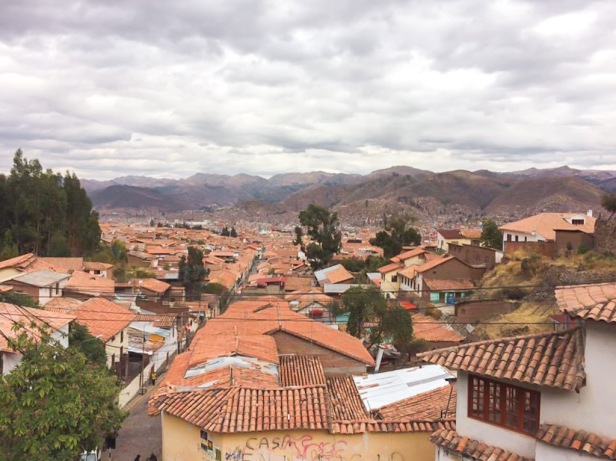
If Cusco is the beginning of your trip, or you are arriving from Lima, it’s a good idea to avoid planning events on the first day of your arrival. The altitude is so high (3,399 metres/11,150 feet) that it really does take some getting used to. For someone who never gets headaches, I had one for the entire first day. The air has less oxygen, and therefore you need to become acclimatized. Most hostels and hotels, as well as restaurants, serve té de coca (coca tea), which is tea that has been derived from the Coca plant and is widely used to help with altitude sickness and discomfort. I drank it every day. You will also notice that many stores sell products with coca in them, such as candies and the leaves themselves (which you can chew on instead of drinking the tea). I recommend taking in the city on the first day – walking around, finding some eateries and just taking it easy. This is especially a good idea if you plan to hike to Machu Picchu while you are there. Oh, and try to avoid alcohol while you acclimatize. Alcohol interferes with the body’s ability to absorb oxygen, and since it’s already lacking in the air, it’s not the greatest idea to drink it when you are trying to get used to the altitude. I know, it sucks.
Accommodations:
There are so many great hostels in Cusco. I stayed in a few while I was there.
Supertramp – Firstly, Supertramp. Yes, great name, I know. This hostel is GOALS. The view is incredible, which is why many backpackers choose it. Perched on top of a hill, it looks out onto the entire city, and a view like that never gets old. Eat your breakfast while looking through the gorgeous large windows in the lounge area, or just chill on one of their cozy bean bag chairs with a book.

Let’s talk about the negatives of this hostel first, just to get them out of the way: It’s location is at a high point in the city. Meaning, you need to climb a lot of stairs to get there, which I didn’t find too bad, but with the altitude, it was sometimes difficult. The night I arrived (on my first night in Cusco, not yet accustomed to the altitude), I remember my taxi driver pulled up, grabbed my bag from the trunk and practically ran up the hill while I was left behind huffing and puffing trying to climb the stairs. He probably waited at the top for a few minutes until I arrived…Poor guy. The high location of this hostel also meant it was cooler here at night. And, since hostels don’t typically have heat, I froze in my top bunk each night (as I visited Cusco in July, Peru’s winter). I literally had to sleep in a toque and mitts to gain any sort of comfort. Finally, it is a bit far from the main square, which again, I didn’t necessarily mind, because I LOVED walking the streets of Cusco. Those are the only downfalls that I can think of, because overall, this place is amazing.

Supertramp is a burst of colour and ‘coolness.’ The staff were all young and friendly (many of them speaking little English, which I always consider a plus as it makes the experience more authentic and excitingly challenging). The buildings exterior and interior are covered with bold paintings created with the brightest hues. It brings a lot of character and style to the hostel. The rooms continue with this bright theme, as the beds are privatized by colour-themed curtains and matching geometric wall patterns. It also has a little seating area in front of a large window on your way to your bunk, where you can read with a view or play games with other guests.
One feature I always look for when booking a hostel is that breakfast is included. Supertramp’s breakfast was basically bread with a few different spreads, including butter and jam. They also served juice and coffee. It’s definitely carb-forward, but they had many great menu choices that you could opt for if you wanted to spend the money. They also served dinner later on, one of the best soups I had while in Peru!

Overall, Supertramp is a great place to stay. It has a certain “calmness” about it that creates more of a “chill” vibe for it’s guests. I would recommend checking it out for at least one night while in Cusco.
Nao Victoria – Equally amazing was the Nao Victoria Hostel. This accommodation is more central, located just steps away from Plaza de Armas (the main square). Alike Supertramp, Nao Victoria had some seriously cool artwork that helped define it. Unlike Supertramp, it’s style was more Victorian, hence the name. When I think back to my time at this hostel, it’s only good memories. The people were so nice and helpful.

I was really sick for a few days while in Cusco, and the Australian who co-owned this place brought me back to life with his amazing restaurant menu, including the best avocado toast I have ever had. It is a quieter place with comfortable beds, an artistic atmosphere, a funky lobby and some really cool vibes.
The dorms were clean, comfortable and private. Each bed had a curtain, a light and a charging socket. Some rooms had private bathrooms and others had ones just outside the room that were also private. There was also a communal bathroom with showers.

A bonus was that it also included free breakfast. And as already mentioned, all of the food was amazing.
If you are looking for more options, here are some of the highest rated hostels in Cusco, with a bit of what you can expect if you book there:
Puriwasi – A safe, friendly hostel with a social vibe and only a few blocks away from the main square.
Pariwana – A clean, party hostel that offers free breakfast and a large open terrace. They provide theme parties and daily happy hour. Free earplugs too – BONUS!
Kokopelli – Highly rated and it’s clear why. A true ‘traveler’ vibe – Not too party-ish, but a great place to meet people! Also, they have many fun games such as a pool table and foosball.
Hospedaje Turistico Recoleta – A small hostel with max. 4 beds to a dorm. Home to a lot of little ‘nooks’ to read, chill or meet people in. Breakfast included.
Food:
Quite honestly, I didn’t find Cusco to have the best food. It may be because I got very sick off of the food here, and apparently, parasites are common (according to a local and many other travelers that experienced the same thing while in Cusco).

My recommendations would be to stick with foods that are cooked and avoid foods that may be washed with the water, such as fresh fruits. There are many restaurants in Cusco that offer soups (especially quinoa) that may be a safe bet. Here are some restaurants that I would recommend:
Yaku Cocina de Altura – A place to go to enjoy local food. They serve up popular Peruvian dishes such as Lomo Saltado (steak and french fries), cuy (Guinea Pig) and ceviche.
Organika – A healthier joint that offers vegetarian and gluten-free options.
Chakruna Native Burgers – If you are looking for comfort food, check out the burgers at Chakruna. They have a number of different options, including an alpaca burger and a vegetarian quinoa burger!
Things to do:
Where do I begin?! Cusco has countless adventures to go on each day, many of which are walkable and others that require a few hour drive.

Walking around Cusco is never boring. It’s cobblestone streets and mountainous landscape make it extremely picturesque. One of my favourite things to do when I wasn’t taking lengthy day trips was to just walk the streets, exploring and getting lost. I ended up finding my favourite place in the city this way, Mirador de San Cristobal, which I frequently visited for the outstanding panoramic and instagrammable photo-ops. This is a church with a large, open “lookout” where I spent a lot of my downtime, just chilling and absorbing the gorgeous views, especially at night when the city was all lit-up. I didn’t actually go into the church, but the inside looks stunning as well. There are benches on the lookout where you can sit and take in a perfect glimpse of Plaza de Armas. I would say it sits in the middle of the lowest and highest points of Cusco, making it a bit easier to get to than my next need-to-see place – Cristo Blanco.

Cristo Blanco is like a miniature version of Christ the Redeemer, in Rio, Brazil. It sits atop the city, overlooking it with arms wide open. I knew I wanted to visit it before I left Cusco, but as a backpacker, I didn’t want to pay for the price of admission (you need to purchase a Tourist Ticket of Cusco, which gives you access to Saysaqhuaman, the ruins next to Cristo Blanco). The ticket also gives you access to a few other popular attractions in Cusco, but goes for 130 Sols, or $50 CAD/$37 USD, so instead, I found a way of walking up, and it was 100% free. Well, originally, I tried walking up by myself, just letting the overarching view of the structure guide me, and that was a flop. I couldn’t find out how to get up there and none of the locals seemed to understand my broken Spanish (I don’t blame them)! Luckily, I ran into a few wonderful humans at my hostel, overheard them talking about going up, and asked if I could join. Evidently, the passage up was right beside the hostel we were staying at (Supertramp), but you would never know it. We fought our way through a forest on a steep uphill climb. It was a tricky hike with the altitude, but after about 20 minutes, we made it. And, let me tell you, the view was amazing! As stated already, Cusco is probably the most beautiful city I have ever visited, but even better from the top of that hill.
The greatest part about discovering the free path to Cristo Blanco was also that we were able to check out Saqsayhuaman on our way back (via the more traditional, mapped out route). Located at 3,700 metres (12,140 feet) above sea level, Saqsayhuaman is a complete mystery. Thought to be an old fortress, Saqsayhuaman is an impressive architectural feat made up of massive stones that have been carefully fitted together. It is a true depiction of the impressive stonemasonry of the Incas.

Moving along with our walking tour, another neat place to hang out is, of course, Plaza de Armas – the main square in Cusco. You will likely walk through it many times, taking in the beautiful cathedrals and constant flow of people. The main square is surrounded by a number of different restaurants (including your standard McDonalds and Starbucks). It is home to a number of vibrant gardens and many cultural events. While I was there, I also witnessed many protests led by locals, which were always peaceful.
Two main attractions at Plaza de Armas are the Cusco Cathedral and Iglesia de la Compañía de Jesús – two stunningly beautiful churches that embody the Baroque-style of grandeur architecture. They are both worth a visit, or at least a dedicated few minutes to sit on the steps and soak up the beauty of the buildings’ facades.
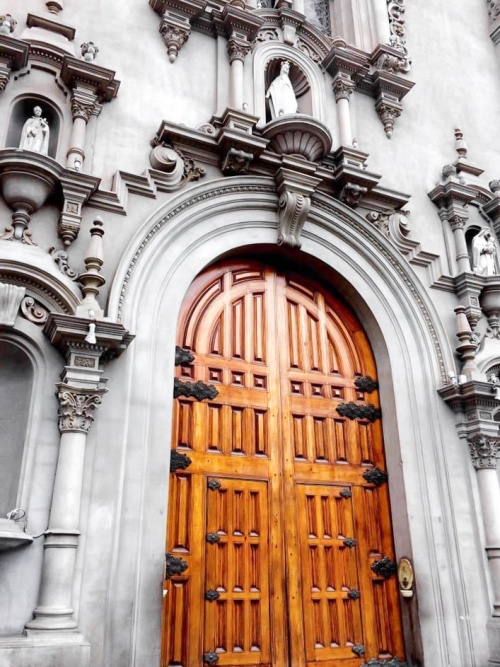
Heading over to the opposite side of the city, you will find San Pedro Market – A definite must-see. The market is quite large and is about a ten-minute walk from Plaza de Armas. There, you will find countless food vendors, juice stations and many, many souvenirs that you can pick up for friends and family. It is a straight hustle of workers trying to sell you their food/drinks and a mash up of different local products. Be selective when choosing what to purchase – food-wise. I’m quite certain I was sick off of one of the fruit juices I had here…Make sure they use bottled water!

What I did love about this market was simply walking through and looking at all of the different stalls and what they had to offer -many of which were the same. I purchased a beautiful, “Alpaca Soft” blanket from here, which is the only souvenir I bought for myself while in Peru, and it was worth it! It’s important to note that you can bargain with the vendor owners and try to get them to lower their prices, often they will as they are competing with the others around them.

There are many other interesting sights to see when walking the streets of Cusco, and I highly recommend taking a day or two to just explore and visit the different ends of the city. A few more worthwhile visits include:
Choco Museo – Pop in and check out how this company uses Peruvian cocoa beans in yummy and unique ways. You can also sign up for a workshop to make your own chocolate treats!
Museo de Arte Precolombino – A pre-Columbian art exhibit that showcases a number of different artifacts from thousands of years ago.

Palacio de Justicia – A gorgeous courthouse located in Cusco’s historic centre. Worth a quick walk-by, just to take in the views.
Day Trips
Aside from all of the places to visit within the city, Cusco is also a direct link to a number of other worthwhile sites. Obviously, Machu Picchu is the most popular, however there are so many other day trips that should be experienced while here.
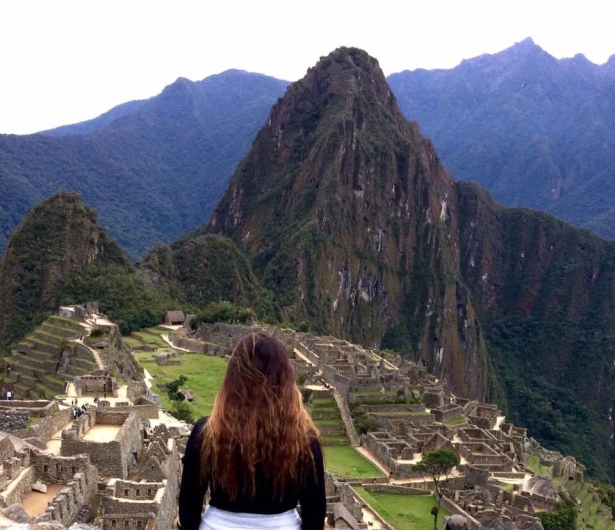
Firstly, Rainbow Mountain. The name says it all – an extremely gorgeous spectacle that captures the eye with it’s stripes of colours formed from mineral deposits and glacial melting. I was juggling whether or not to make the day-long journey, and after much thought, I decided…por que no?! Or…why not? And then, I got sick and it sadly eliminated two days off of my trip in Cusco, leaving me no time to make the visit to Rainbow Mountain. Although I don’t have the experience to tell you firsthand about this landmark, I did do a lot of research on the mountain when I was debating whether or not to go. So here is what you need to know:
- Rainbow Mountain sits at 5, 200 metres (17, 060 feet), higher than both the city of Cusco and Machu Picchu, meaning you need to be prepared. Do NOT think that you can show up in Cusco and hike Rainbow Mountain the next day. Your body will need time to acclimatize or else you will likely experience severe headaches and altitude sickness. The tour operators have oxygen and first aid on-hand in case of emergency.
- It is a full-day excursion. Regardless of the tour you book, you will likely be picked up early in the morning (4 or 5 a.m.) to start the trek. There is a lot of driving to get to the mountain, often with a stop for breakfast on the way there and lunch on the way back. The hike itself will take anywhere from 1 to 2 hours with no more than a 20 minute stay at the top. The descent adds on another 45 minutes to an hour.
- There is an option to ride a horse to the top if you are struggling to complete the hike, but these often cost a lot of money.
- Rainbow Mountain Travel offers a tour for $30 USD, which includes pick-up, a guide, entrance into the Rainbow Mountain park, a first aid kit and oxygen tanks for emergencies.
Overall, if you can squeeze it in, you should. The landscapes are incredible and you will have gorgeous photos to prove it!
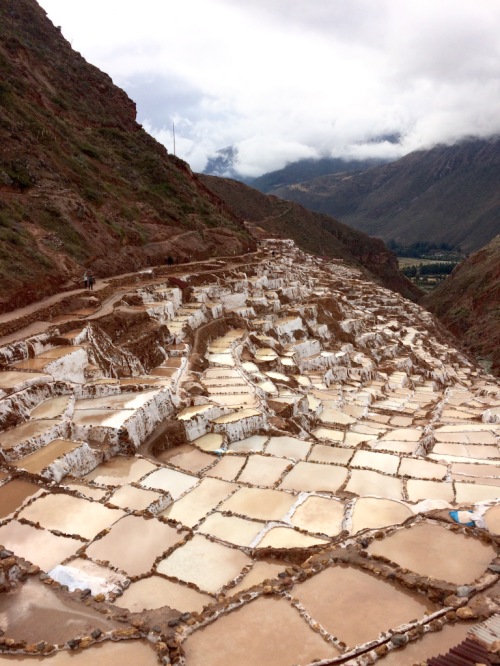
Salineras de Maras and Moray are two more worthwhile trips to take out of Cusco. Salineras de Maras, or the salt mines of Maras, are a must-see. The pictures don’t do this place justice. Visit this insane landscape to take in thousands of salt pools carved into the side of a mountain. Here you can walk amongst the labyrinth of wells, stick your finger in one and taste the immense saltiness of the natural springs. Salineras de Maras also has a number of gift shops that sell salt products, which you should definitely check out. I purchased a few small bags of pink salt, as well as some salted chocolate and I wish I bought more. It is some of the best salt I have ever had. Worth it!

Moray is close to Maras, and it boasts a collection of circular-shaped terraces thought to have been built for agricultural purposes. As you move up from the central (lowest) part of the site, the temperature drops significantly, making it a perfect place to test how certain crops grow in different types of weather. Often, tours here will also include a stop at Maras to see the salt mines. I took a tour that included a full day on a quad with a few fun stops on the way. This is a great way to spend a day close to Cusco!
Machu Picchu
Let’s talk about Machu. This place is magical. Somehow, when I was there, surrounded by tourists and visitors, I felt a sense of calm wash over me. If you do get the opportunity to visit, you will notice many people (of which many were fast asleep and snoring loudly) relaxing on the hills found around the ruins. I truly believe that aside from likely being exhausted from making the trek to Aguas Calientes, they were enjoying the peaceful atmosphere and complete serenity that surrounds Machu Picchu.

How to get there: You have a few options when traveling to Machu Picchu. There are several hikes that leave every day from Cusco to Aguas Calientes (the connecting city beside Machu Picchu). The two most popular are the Inca Trail and Salkantay Mountain. The Inca Trail is a 4-day hike that takes you through historical sites and diverse scenery. It is known to be an easier trek than the Salkantay trek, which boasts beautiful mountainous views, higher altitudes and more kilometres. Salkantay is the more challenging hike, so if you are looking for a great workout, opt for that one. I started the hike on Salkantay, but unfortunately got really sick and had to cut it short.

If hiking isn’t your forte, you can always take the train into Aguas Calientes. I ended up doing this once I recovered and was ready to try again. I took a cab into a town called Ollantaytambo (about an hour from Cusco) and from here, boarded the Peru Rail. Tickets were pretty expensive at S/ 385, or $140 CAD ($108 USD) roundtrip. Granted, the seats are comfortable and some of the trains provide a snack each way. I purchased my train ticket the day before and it wasn’t a problem, but I would still suggest purchasing ahead of time, just in case.
Getting to Machu Picchu from Aguas Calientes: There are two tickets you can buy for entrance into Machu Picchu – The morning shift (6 a.m. to 12 p.m.) or the afternoon shift (12 p.m. to 5:30 p.m.). I suggest the morning shift. Be ready to wake up super early. If you are a backpacker, this is probably the norm for you, especially in Peru. Everything starts so early because it takes a long bus ride to get to most places in the Sacred Valley. Buses start running from Aguas Calientes to Machu Picchu at 5:30 a.m., but there is always a massive line earlier than that to get on the first few buses. Buses go up every 15 minutes and the ride up takes about 20 minutes. Alternatively, you can hike up, which takes just over an hour. The citadel opens at 6:00 a.m., and if you can get there by then, you may be blessed with a gorgeous sunrise…depending on the weather. When I was there, the clouds were so low (or the landscape so high) that I didn’t get to take advantage of what could have been a stunning photo op. It all depends on the day.

When you get there: Right before entering, make sure you grab a stamp on your passport saying you have been to Machu…It’s free! Once you get into the citadel I would recommend taking in the view from an area that is just below a little “guard house.” This is a very “Instagrammable” location that has the perfect view of the citadel. Grab all your pictures and lay out on the grass for a bit to enjoy the view and the serenity before heading down into the actual ruins.
As you move about the ruins, pay attention to the architecture and the way the builders developed the city. You will notice how logical the placement of certain things are, like the windows, where they take advantage of the sun from the East, and the stones, which have been fitted together perfectly and have lasted the test of time. To be in a place that dates back to so long ago is truly an out-of-this-world experience.

If you enjoy hiking and want an even better view of the citadel, make sure you purchase a combination ticket that allows you to visit either Huayna Picchu (Young Mountain) or Machu Picchu Mountain (Old Mountain). Huayna Picchu Mountain is a steep climb with many large stone steps. It is a fairly challenging hike, with narrow paths, tight staircases and rock tunnels. Machu Picchu Mountain starts out wider and at an easier slope, but then becomes a steeper climb as you ascend. It is also at a higher altitude compared to Huayna Picchu. Both are worth the view if you are up for the added challenge.
Getting Home: If you are taking the bus home, prepare to wait in another long line. Luckily buses are constantly making the trip up, dropping off people and reloading those who are done their excursion and heading back for the day. You can also hike back down to save some cash.
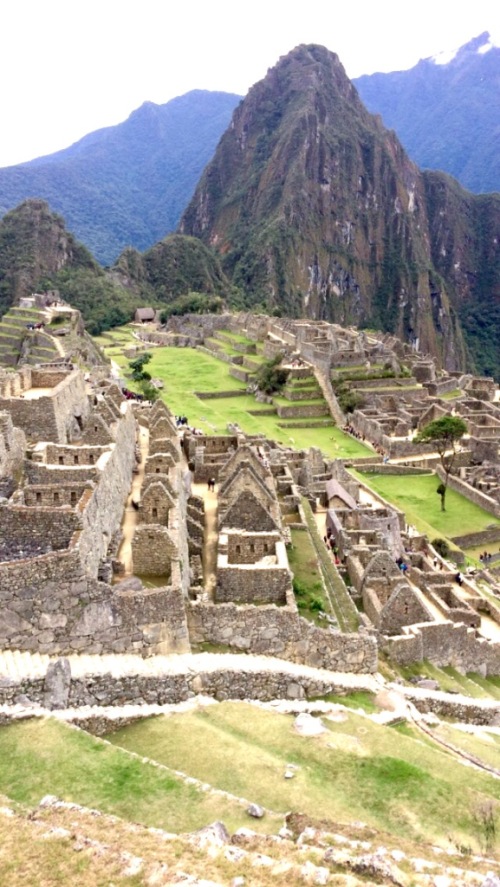
Overall, Cusco is the most beautiful city, and Machu Picchu is the most beautiful citadel. Set aside as much time as you can to visit both.
One Comment
Comments are closed.